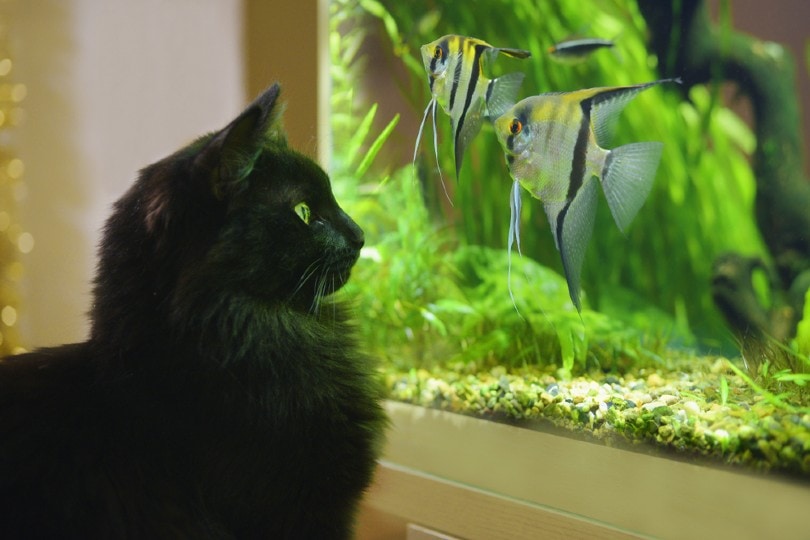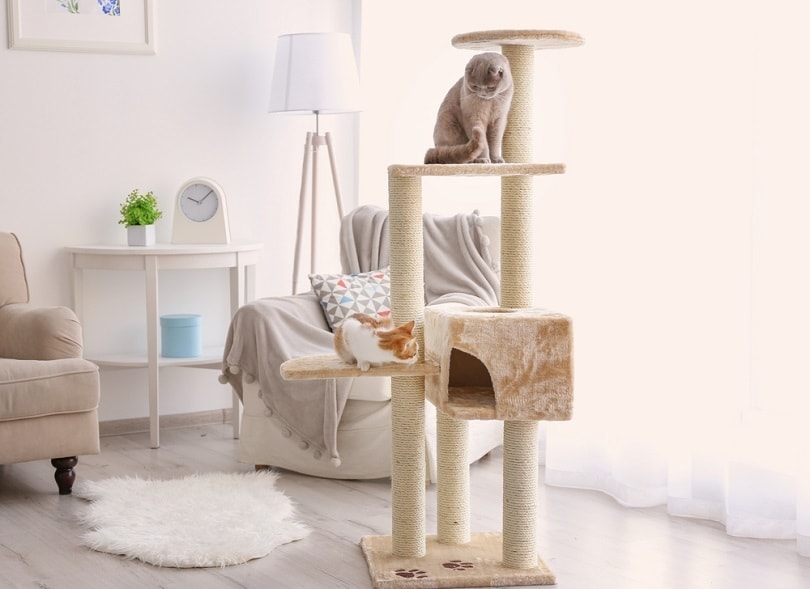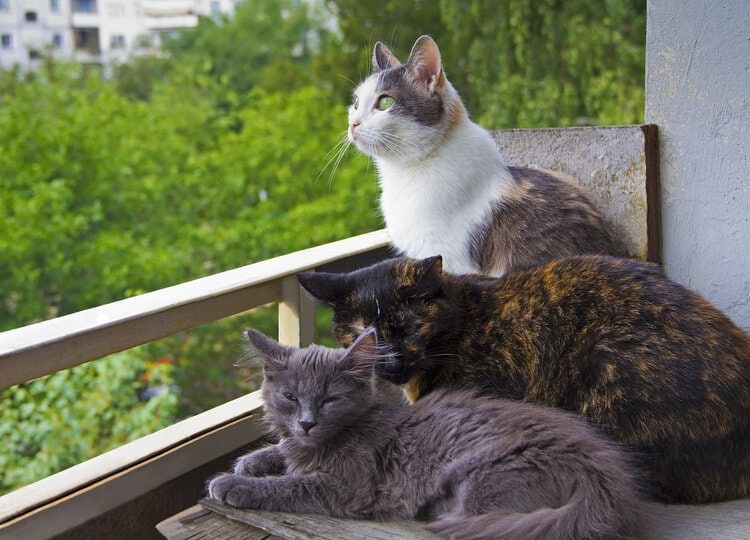How to Cat-Proof a Fish Tank: 8 Vet-Approved Ways
Updated on

Cats are naturally curious creatures. If you have a fish tank, you may have noticed that your cat is mesmerized by it, watching the fish swim around. Cats are attracted to the quick movements of fish. This triggers their hunting instincts. If they have the chance, it’s not uncommon for cats to stick a paw in the water to try to grab one of these unsuspecting tank dwellers.
Just because the fish tank fascinates your cat doesn’t mean they should have access to it, though. In this article, we look at eight ways to cat-proof a fish tank so your fish stay safe and protected even when you’re not home.
The 8 Ways to Cat-Proof a Fish Tank
1. Cover the Tank and Use Tanks With Lids
This might seem like an obvious solution, but if your fish tank is covered, this solves a few problems. By placing a breathable blanket or towel over the tank, your cat loses their free show. This will only work if your tank has a lid, so be aware of that. If your cat jumps onto the blanket thinking that it’s a solid surface, they can wind up in the tank if it doesn’t have a lid. A cover may also muffle some of the noise coming from the tank, like bubbling water.
You can cover the tank when you are out of the house, sleeping, or any time that you’re unable to supervise your cat. Covering the tank will make for a boring view, and your cat will lose interest in what’s underneath.
- Easy to do when necessary
- Causes cats to lose interest
- Only tanks with lids can be covered

2. Give It an Unpleasant Texture
Using double-sided tape line the top of the tank’s lid or the sides of the tank where your cat likes to paw at it. Cats don’t like the texture of tape. You can even use the tape around the tank where your cat likes to sit. Cats will avoid surfaces that don’t feel good to them, so you can discourage them from hanging out around the tank this way.
- Easy and effective
- Can be placed anywhere
- Needs to be replaced often
- Can be costly
3. Use Unappealing Scents
Cats may be attracted to fish tanks because of their smell. Always store fish food in a cabinet that your cat cannot access, and keep the tank clean. A clean tank won’t give off as much odor as a dirty one. Cats aren’t fans of citrus scents. Place lemon, orange, or grapefruit peels in a bowl near the tank, preferably where your cat likes to sit. By reducing the fish tank odors and adding in scents that your cat doesn’t like, they could quickly lose interest in the fish tank.
Be sure to check on and replace your citrus peels if they start to dry out. The sugar from the fruit may attract insects, so always remember to check the peels and see if they are causing any issues.
- Cheap solution
- Many people enjoy citrus scents
- Easy
- Peels need to be discarded and replaced often
- May attract insects

4. Use a Sealed Lid
A lid for your fish tank is a must, especially if you have a cat. The best lid to use is one that comes with your tank. Otherwise, you have to make sure it fits properly with no gaps or spots where it will bend or crack. The lid will reduce the sounds and smells coming from the fish tank.
However, this will act as an invitation to most cats, which will jump on the lid and use your fish tank as a napping spot. It may seem adorable to let them do this, but it will stress out your fish and may even be dangerous for your cat if the lid cracks or breaks. It’s not a good idea to let your cat sleep on the lid. You can stack things on top of the lid to keep your cat off of it or use some of the other suggestions on this list, like double-sided tape or citrus peels. You can also use a cover when your tank has the lid securely in place.
- Easy option
- Some tanks come with lids
- Easy to use other methods with a lid
- Cats may want to sleep on the lid
- May need to be used with other methods

5. Offer Distractions
Cats may be visiting your fish tank because they’re bored. One way to combat this is to make other areas of the house more enticing for them. Set up more cat trees, get a window perch, and offer your cat a selection of toys in other parts of the house to have them spend more of their time in these spots. Be sure to rotate the toys often so your cat doesn’t get bored. You can also use cat grass, catnip, and treat dispensers to make your cat wonder what they ever saw in those fish in the first place. If you increase playtime with your cat, this can help too. Not only will they get more exercise, but it’s also a good way for you both to bond.
- Keeps the cat’s attention off your fish
- Offers more entertainment for cats
- Helps cats get more exercise
- Could be expensive

6. Rearrange the Room
Make sure the fish tank is in a place that is inconvenient for the cat. If you’re using a stand, the tank should fit in the stand with no room on the sides for a cat to jump up and perch. Remove any furniture near the tank. Cats will use anything for a launching pad, so keep tables, chairs, and sofas away from the tank. The tank will be cat-proof if there’s no way for the cat to jump up next to or near it. This may not be an option in every home. Depending on the size of the living space, some furniture can’t be moved around once it’s set.
- Solves the problem
- Leaves no room for cats to interact with the tank
- Not all living spaces have enough room for rearrangements
7. Close the Door
This seems like an obvious option but it won’t work for everyone. If your fish tank can’t be moved and it isn’t already in a room with a door, this isn’t a suitable method. If your fish tank is in your bedroom, closing your door means you’re keeping your cat out. This can lead to them crying at the door and being upset that they are away from you.
If you can move the fish tank into a separate room where the door can be kept closed when you’re sleeping or not home, that might be a better solution. It also might mean that you can’t enjoy your fish tank if you don’t spend much time in that room, though.
- Simplest solution
- Costs nothing
- Cat may cry or meow at the door
- Fish tank may be out of your view

8. Use Repellents
A spray repellent can be useful in keeping your cat away from your fish tank. The spray is ideal for repelling cats harmlessly and can be sprayed anywhere that you don’t want your cat to go. Just make sure you don’t spray any of it into your fish tank’s water.
The spray may have to be applied daily. Once the scent fades, it will no longer be effective.
- Easy to use
- Effective
- Care must be taken to not get it into the tank
- Must be reapplied often
Why Are Cats Attracted to Fish Tanks?
Cat owners may notice that their cats are obsessed with the fish tanks, but why? Many cats are notorious for not liking water, so why do they like the fish tank? There are a few reasons for this.
Water
Most cats dislike being wet but they may like water just fine. If you have a cat that plays in their water bowl or bats at a stream of water from the faucet, you understand this. A cat playing in the water is different from a cat being dunked in a full kitchen sink for a bath.
Wild cats get their water from running water sources, like streams and rivers. The sound of the water attracts them. This is also why water fountains for cats are so popular with pet owners. Many cats won’t drink from a bowl but they’ll drink from running water. If your fish tank has a filter, the sound of the water moving can be enough of a draw for a cat to a fish tank even if it holds no fish.
Cats Are Hunters
Cats are drawn to the movements that fish make as they swim. Darting around can get cats interested quickly and put them in hunting mode.
It’s Warm
If your fish tank is heated, your cat might be attracted to the warmth. If they lie next to or on top of the tank, they may be enjoying the heat. This is dangerous because your cat could potentially fall into the tank. They will also scare the fish!
While we know that cats are always interested in lying in spots that are the most inconvenient for us, it’s best to keep them away from fish tanks as much as possible. You never want to put your fish in danger. Your cat will be perfectly content if they can’t have access to the fish tank. If you provide them with enough things of their own, they won’t even miss it.
Final Thoughts
It’s possible to have both a curious kitty and a tank full of fish without your fish becoming a snack for your cat. By cat-proofing your fish tank, you can be sure that all your fish remain safe and protected. We hope that these methods have helped you find the right solution so you can stop worrying about your fish and go back to enjoying them.
Featured Image Credit: DMITRII STARTCEV, Shutterstock












